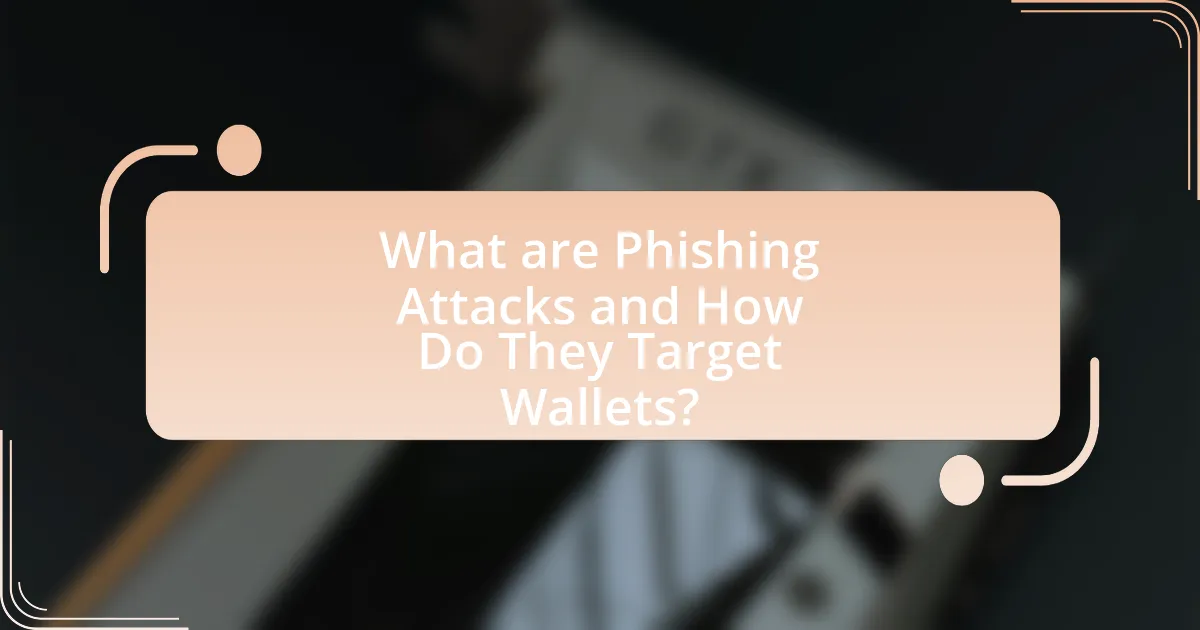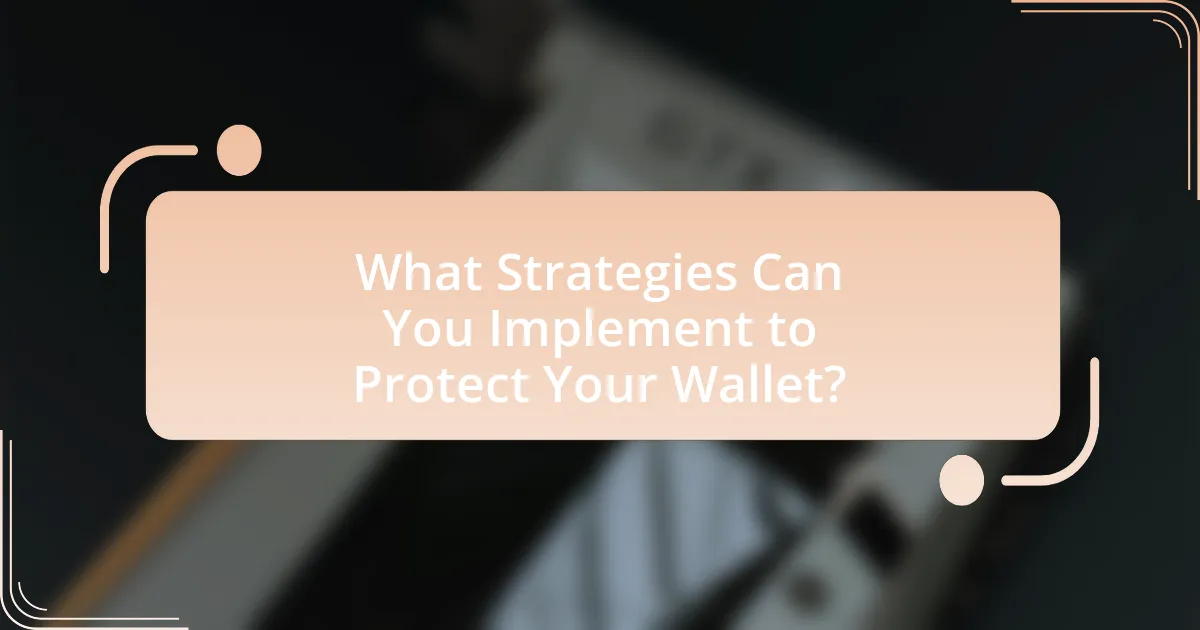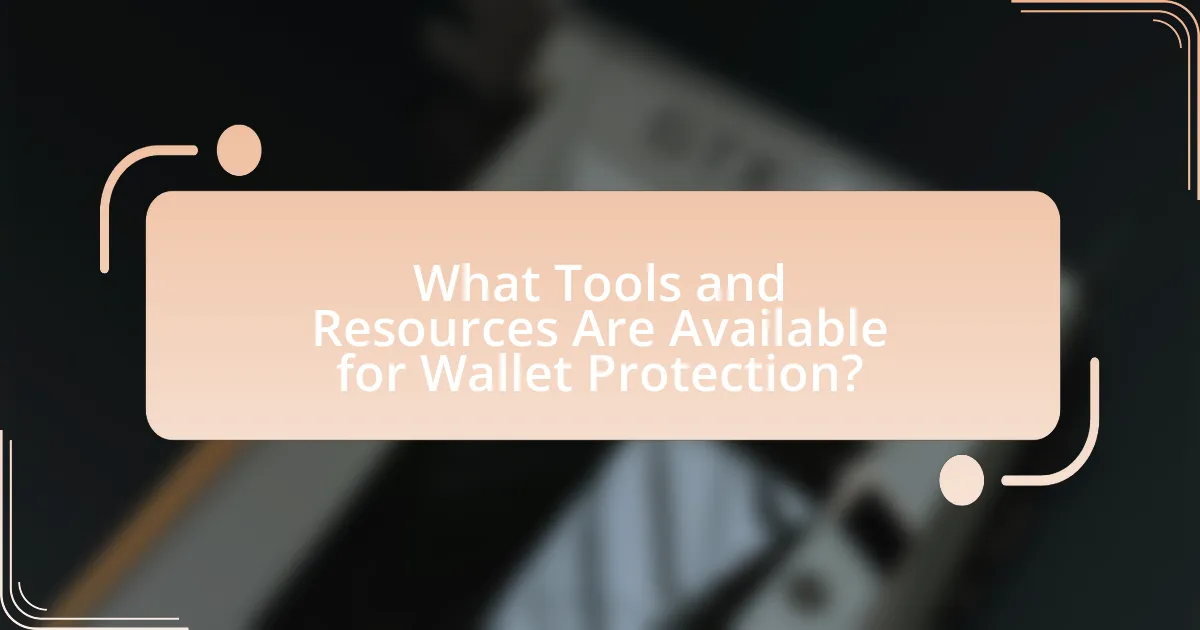Phishing attacks are deceptive tactics used by cybercriminals to obtain sensitive information from users, particularly targeting digital wallets. This article outlines the mechanisms of phishing attacks, including the use of fraudulent emails and websites that impersonate legitimate wallet providers. It emphasizes the importance of safeguarding wallets through strategies such as multi-factor authentication, strong password practices, and the use of security software. Additionally, the article provides insights on recognizing phishing attempts, the potential consequences of falling victim to such attacks, and resources available for ongoing protection against these threats.

What are Phishing Attacks and How Do They Target Wallets?
Phishing attacks are deceptive attempts to obtain sensitive information, such as passwords or financial details, by masquerading as a trustworthy entity in electronic communications. These attacks specifically target digital wallets by sending fraudulent emails or messages that appear to be from legitimate wallet providers, prompting users to click on malicious links or provide personal information. According to the Anti-Phishing Working Group, there were over 200,000 reported phishing attacks in a single month in 2021, highlighting the prevalence of this threat. By exploiting social engineering tactics, attackers create a sense of urgency or fear, convincing users to act quickly without verifying the source, thereby compromising their wallet security.
How do phishing attacks work in the context of digital wallets?
Phishing attacks in the context of digital wallets typically involve cybercriminals impersonating legitimate services to deceive users into revealing sensitive information, such as passwords or private keys. These attacks often occur through fraudulent emails, messages, or websites that closely mimic the appearance of trusted wallet providers. For instance, a user may receive an email that appears to be from their digital wallet service, prompting them to click a link that leads to a fake login page designed to capture their credentials. According to the Anti-Phishing Working Group, there were over 200,000 phishing attacks reported in the first quarter of 2021 alone, highlighting the prevalence and effectiveness of such tactics in targeting digital wallet users.
What techniques do attackers use to deceive wallet users?
Attackers use techniques such as phishing emails, fake websites, and social engineering to deceive wallet users. Phishing emails often impersonate legitimate services, prompting users to click on malicious links that lead to counterfeit websites designed to capture sensitive information. Fake websites can closely mimic the appearance of genuine wallet platforms, tricking users into entering their credentials. Social engineering tactics involve manipulating users into revealing personal information through trust-building conversations or urgent requests. These methods exploit human psychology and the trust users place in familiar brands, making them effective in compromising wallet security.
How can users identify phishing attempts targeting their wallets?
Users can identify phishing attempts targeting their wallets by scrutinizing the authenticity of communications and websites. Phishing attempts often involve emails or messages that create a sense of urgency, prompting users to click on suspicious links or provide sensitive information. Additionally, users should look for signs such as poor grammar, unusual sender addresses, and mismatched URLs that do not correspond to legitimate wallet services. According to the Anti-Phishing Working Group, in 2022, over 1.5 million phishing sites were reported, highlighting the prevalence of these attacks and the importance of vigilance in recognizing them.
Why is it important to safeguard your wallet from phishing attacks?
Safeguarding your wallet from phishing attacks is crucial to protect your financial assets and personal information. Phishing attacks often involve deceptive emails or websites that impersonate legitimate services to steal sensitive data, leading to unauthorized access to your accounts. According to the Anti-Phishing Working Group, there were over 200,000 reported phishing attacks in a single month in 2021, highlighting the prevalence and risk associated with these threats. By implementing security measures, such as two-factor authentication and being vigilant about suspicious communications, individuals can significantly reduce the likelihood of falling victim to these attacks and safeguard their financial well-being.
What are the potential consequences of falling victim to a phishing attack?
Falling victim to a phishing attack can lead to significant financial loss and identity theft. Victims may unknowingly provide sensitive information, such as bank account details or passwords, which cybercriminals can use to access financial accounts or commit fraud. According to the Anti-Phishing Working Group, in 2021, phishing attacks resulted in losses exceeding $1.8 billion in the United States alone. Additionally, victims may face long-term consequences, including damage to credit scores and the emotional distress associated with identity theft.
How can phishing attacks impact your financial security?
Phishing attacks can severely compromise your financial security by enabling cybercriminals to gain unauthorized access to sensitive financial information, such as bank account details and credit card numbers. Once attackers acquire this information, they can execute fraudulent transactions, leading to significant financial losses. According to the Federal Trade Commission, consumers reported losing over $1.9 billion to fraud in 2020, with phishing being a leading method of attack. This demonstrates the direct correlation between phishing attacks and financial vulnerability, highlighting the urgent need for protective measures against such threats.

What Strategies Can You Implement to Protect Your Wallet?
To protect your wallet from phishing attacks, implement multi-factor authentication (MFA) for all accounts linked to your wallet. MFA adds an extra layer of security by requiring not only a password but also a second form of verification, such as a text message or authentication app code. According to a study by Google, MFA can block 99.9% of automated attacks, significantly reducing the risk of unauthorized access to your wallet. Additionally, regularly updating your passwords and using unique passwords for different accounts further enhances security, as weak or reused passwords are common vulnerabilities exploited by attackers.
How can you recognize and avoid phishing scams?
To recognize and avoid phishing scams, individuals should look for signs such as suspicious email addresses, poor grammar, and urgent requests for personal information. Phishing scams often use deceptive tactics to mimic legitimate organizations, making it crucial to verify the sender’s identity before responding. For instance, according to the Anti-Phishing Working Group, in 2021, over 80% of reported phishing attacks involved email, highlighting the importance of scrutinizing email communications. Additionally, using security software and enabling two-factor authentication can significantly reduce the risk of falling victim to these scams.
What are the signs of a phishing email or message?
Phishing emails or messages typically exhibit several key signs that indicate their fraudulent nature. Common indicators include poor spelling and grammar, which often suggest a lack of professionalism; generic greetings such as “Dear Customer” instead of personalized salutations; and urgent calls to action that pressure the recipient to respond quickly. Additionally, phishing attempts often contain suspicious links or attachments that may lead to malicious websites or malware. According to the Anti-Phishing Working Group, in 2021, 83% of phishing emails contained these characteristics, reinforcing the importance of recognizing these signs to protect oneself from potential scams.
How can you verify the authenticity of a wallet-related communication?
To verify the authenticity of a wallet-related communication, always check the sender’s address and ensure it matches the official communication channels of the wallet provider. Phishing attacks often use similar-looking email addresses or URLs to deceive users. Additionally, look for signs of secure communication, such as HTTPS in the URL and the presence of a digital signature if applicable. According to the Federal Trade Commission, legitimate companies will never ask for sensitive information via email, reinforcing the need to verify the source before responding or clicking on links.
What security measures should you adopt for your wallet?
To safeguard your wallet from phishing attacks, adopt measures such as enabling two-factor authentication (2FA), using strong, unique passwords, and regularly updating your wallet software. Two-factor authentication adds an extra layer of security by requiring a second form of verification, making unauthorized access significantly more difficult. Strong, unique passwords reduce the risk of being compromised through credential stuffing attacks, where attackers use stolen credentials from one service to access another. Regularly updating wallet software ensures that you benefit from the latest security patches and features, which are crucial in protecting against vulnerabilities. These measures collectively enhance the security of your wallet against phishing threats.
How can two-factor authentication enhance your wallet’s security?
Two-factor authentication (2FA) enhances your wallet’s security by requiring two forms of verification before granting access, significantly reducing the risk of unauthorized access. This additional layer of security ensures that even if a password is compromised, an attacker would still need the second factor, such as a code sent to a mobile device, to gain entry. According to a study by Google, implementing 2FA can block 99.9% of automated attacks, demonstrating its effectiveness in safeguarding sensitive information against phishing and other cyber threats.
What role do strong passwords play in safeguarding your wallet?
Strong passwords are essential in safeguarding your wallet by providing a robust defense against unauthorized access. A strong password typically includes a mix of uppercase and lowercase letters, numbers, and special characters, making it significantly harder for attackers to guess or crack through brute force methods. Research indicates that 81% of data breaches are linked to weak or stolen passwords, highlighting the critical need for strong password practices. By using complex passwords, users can greatly reduce the risk of their wallets being compromised, thereby enhancing overall security against phishing attacks.

What Tools and Resources Are Available for Wallet Protection?
Tools and resources available for wallet protection include hardware wallets, software wallets with strong encryption, and multi-factor authentication (MFA) systems. Hardware wallets, such as Ledger and Trezor, store private keys offline, significantly reducing the risk of online attacks. Software wallets like Exodus and Electrum offer encryption and backup features, enhancing security. Multi-factor authentication adds an extra layer of protection by requiring additional verification steps, making unauthorized access more difficult. According to a report by the Cybersecurity & Infrastructure Security Agency, using these tools can mitigate risks associated with phishing attacks, thereby safeguarding digital assets effectively.
What software can help protect against phishing attacks?
Software that can help protect against phishing attacks includes antivirus programs, email filtering solutions, and web browsers with built-in security features. Antivirus programs like Norton and McAfee offer real-time protection against malicious links and phishing attempts. Email filtering solutions, such as Proofpoint and Mimecast, can identify and block phishing emails before they reach the inbox. Additionally, web browsers like Google Chrome and Mozilla Firefox have features that warn users about potentially harmful websites, enhancing overall security against phishing threats. These tools collectively reduce the risk of falling victim to phishing attacks by providing multiple layers of defense.
How do anti-phishing tools work to secure your wallet?
Anti-phishing tools secure your wallet by detecting and blocking fraudulent websites and emails that attempt to steal sensitive information. These tools utilize algorithms to analyze URLs and email content for known phishing patterns, alerting users to potential threats. For example, according to a report by the Anti-Phishing Working Group, over 200,000 unique phishing sites were identified in a single month, highlighting the necessity of such tools. By employing real-time threat intelligence and machine learning, anti-phishing tools can adapt to new phishing tactics, ensuring ongoing protection for users’ wallets.
What are the best practices for using security software effectively?
The best practices for using security software effectively include keeping the software updated, configuring it properly, and utilizing comprehensive features. Regular updates ensure that the software can defend against the latest threats, as cybercriminals continuously evolve their tactics. Proper configuration allows users to tailor the software to their specific needs, enhancing its effectiveness. Additionally, utilizing features such as real-time scanning, firewall protection, and phishing detection can significantly reduce the risk of falling victim to phishing attacks. According to a report by the Anti-Phishing Working Group, organizations that implement robust security software experience a 50% reduction in successful phishing attempts.
How can you stay informed about the latest phishing threats?
To stay informed about the latest phishing threats, regularly follow cybersecurity news websites and subscribe to threat intelligence feeds. Websites like Krebs on Security and the Cybersecurity & Infrastructure Security Agency (CISA) provide timely updates on emerging phishing tactics and trends. Additionally, joining cybersecurity forums and communities can facilitate knowledge sharing among professionals, enhancing awareness of current threats. According to a report by the Anti-Phishing Working Group, phishing attacks have increased significantly, making it crucial to stay updated on the latest methods used by cybercriminals.
What resources provide updates on phishing scams targeting wallets?
Resources that provide updates on phishing scams targeting wallets include cybersecurity websites, government alerts, and social media platforms. Websites like the Anti-Phishing Working Group (APWG) and the Federal Trade Commission (FTC) regularly publish reports and alerts about ongoing phishing threats. Additionally, platforms such as Twitter and Reddit often feature real-time discussions and warnings from users who have encountered phishing attempts. These resources are essential for staying informed about the latest tactics used by scammers, enabling wallet users to take proactive measures against potential threats.
How can community forums and groups help in sharing information about phishing attacks?
Community forums and groups facilitate the sharing of information about phishing attacks by providing a platform for users to report incidents, share experiences, and disseminate knowledge on prevention strategies. These platforms enable real-time communication, allowing members to alert each other about new phishing schemes, which can significantly reduce the risk of falling victim to such attacks. For instance, studies show that community-driven alerts can lead to a 30% decrease in successful phishing attempts within active user groups, highlighting the effectiveness of collective vigilance.
What are the best practices for safeguarding your wallet from phishing attacks?
To safeguard your wallet from phishing attacks, implement multi-factor authentication (MFA) for an added layer of security. MFA significantly reduces the risk of unauthorized access by requiring multiple forms of verification, such as a password and a one-time code sent to your mobile device. According to a study by Microsoft, MFA can block over 99.9% of account compromise attacks. Additionally, always verify the authenticity of emails and links before clicking, as phishing attempts often mimic legitimate sources. Regularly update your wallet software and use strong, unique passwords to further enhance security.